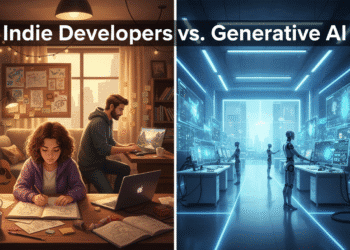Introduction
In a remarkable turn of events, artificial intelligence is now outpacing human experts in predicting scientific research outcomes. A new study from University College London, published in the prestigious journal Nature, has demonstrated that large language models (LLMs) can forecast the results of neuroscience experiments with greater accuracy than seasoned neuroscientists.
The study found that AI models achieved an impressive 81.4% accuracy in predicting whether scientific hypotheses would be supported by experimental data. In stark contrast, human experts reached an average accuracy of only 63.4%. This groundbreaking finding suggests that AI could play a pivotal role in shaping the future of scientific discovery.
AI Outperforms Human Experts
The researchers developed a test called “BrainBench” to evaluate the predictive abilities of both AI models and human experts. The human participants consisted of 171 neuroscientists, ranging from graduate students to professors, with an average of 10.1 years of experience in the field. Each participant was presented with nine research scenarios across various areas of neuroscience. They were tasked with reviewing the methodology and hypotheses to predict whether the experiments would support the researchers’ expectations.

Meanwhile, the AI models were subjected to a more rigorous test. They faced 200 expert-generated cases along with 100 scenarios generated by GPT-4, a state-of-the-art language model developed by OpenAI. Despite the increased difficulty, the AI models consistently outperformed the human experts.
Even among the highest-performing human experts—the top 20%—the accuracy only reached 66.2%. This underscores the significant gap between human and AI predictive capabilities in this context. Moreover, the AI models used in the study were older open-source versions, not the latest iterations from tech giants like Anthropic, Meta, or OpenAI. This suggests that current models such as GPT-4 or Sonnet 3.5 could potentially deliver even better performance.
One of the AI models tested was Meta’s Galactica, which was specifically designed for scientific tasks. Although scientists criticized Galactica upon its release in 2022, it demonstrated superior performance in predicting the results of neurology papers. Other models like Falcon and Llama 2 also showed superior performance in these predictions.
Not Just Memorization
A critical question arises: were these AI models simply memorizing answers from their training data? The researchers tackled this concern using special testing methods. They ensured the AI models had not previously encountered the test cases during training. They compared the results against known training data and found no evidence of mere memorization.
Instead, the AI models seem to process scientific articles in a manner akin to human reasoning. They form general patterns and frameworks rather than relying on rote memorization of details. The models performed exceptionally well when integrating information beyond the abstracts, connecting the methodology and background with the results.
Lead author Dr. Ken Luo commented on this phenomenon: “This success suggests that a great deal of science is not truly novel but conforms to existing patterns of results in the literature. We wonder whether scientists are being sufficiently innovative and exploratory.”
The AI models have the ability to synthesize decades of research. They identify patterns across vast amounts of data. This ability highlights their potential as powerful tools in scientific inquiry. They excel in areas where human information processing capacities may be limited, especially given the exponential increase in scientific literature.

The Future of Scientific Discovery
The implications of this study are profound and far-reaching. AI models can predict scientific outcomes with greater accuracy than human experts. They could revolutionize the way research is conducted. Scientists could leverage AI to guide experimental design, prioritize research efforts, and even uncover novel insights that might otherwise remain hidden.
However, this development also raises important questions about the nature of scientific innovation. If AI models are finding that much of science conforms to existing patterns, does this suggest a need for greater creativity and exploration in research? Are we, as scientists, being too conservative in our hypotheses and methodologies?
Furthermore, there is the potential risk that reliance on AI predictions could inadvertently stifle innovation. Scientists might be dissuaded from pursuing unconventional ideas if AI models predict low likelihoods of success. Conversely, AI could help identify promising but overlooked research avenues by highlighting patterns that humans might miss.
Another consideration is the transparency and interpretability of AI models. While they may provide accurate predictions, understanding the reasoning behind these predictions is crucial. This understanding can inform scientific theory and help researchers make informed decisions about experimental design.
Moreover, the ethical implications of integrating AI into scientific research must be carefully examined. Data privacy needs attention. Bias in training data is also a concern. Additionally, it is vital to address the potential for AI to perpetuate existing scientific paradigms without critical examination.
Potential Applications and Challenges
The use of AI models in scientific research extends beyond neuroscience. Similar approaches could be applied to other fields, such as chemistry, biology, and materials science. Large language models could assist in predicting chemical reactions. They can also help in identifying potential drug candidates. Additionally, they might discover new materials with desired properties.
However, several challenges must be addressed to fully realize the potential of AI in science. One major concern is the opacity of AI models, often referred to as the “black box” problem. Understanding how AI models arrive at their predictions is crucial for trust and adoption in the scientific community.
Moreover, the quality of AI predictions depends heavily on the training data. Biases and gaps in the existing literature could be reflected and even amplified by AI models. Ensuring diversity and representativeness in training data is essential to avoid perpetuating existing biases.
Additionally, there is a need for ongoing collaboration between AI developers and domain experts. Such collaboration can help tailor AI models to the specific needs of different scientific fields, improve interpretability, and ensure that ethical considerations are adequately addressed.
Closing Thoughts
In conclusion, the study from University College London marks a significant milestone in the intersection of artificial intelligence and scientific research. AI models can outperform human experts in predicting research outcomes. This opens up exciting possibilities for the future of science. However, it also prompts critical reflection on the role of innovation. It encourages us to consider the potential limitations of AI. Additionally, we must think about the need for responsible integration of technology into the scientific process.
As we move forward, the integration of AI into scientific research offers exciting opportunities and challenges. It necessitates careful consideration of the ethical, practical, and theoretical implications. The goal should be to enhance scientific discovery. We must maintain a commitment to innovation, transparency, and responsible use of technology.









